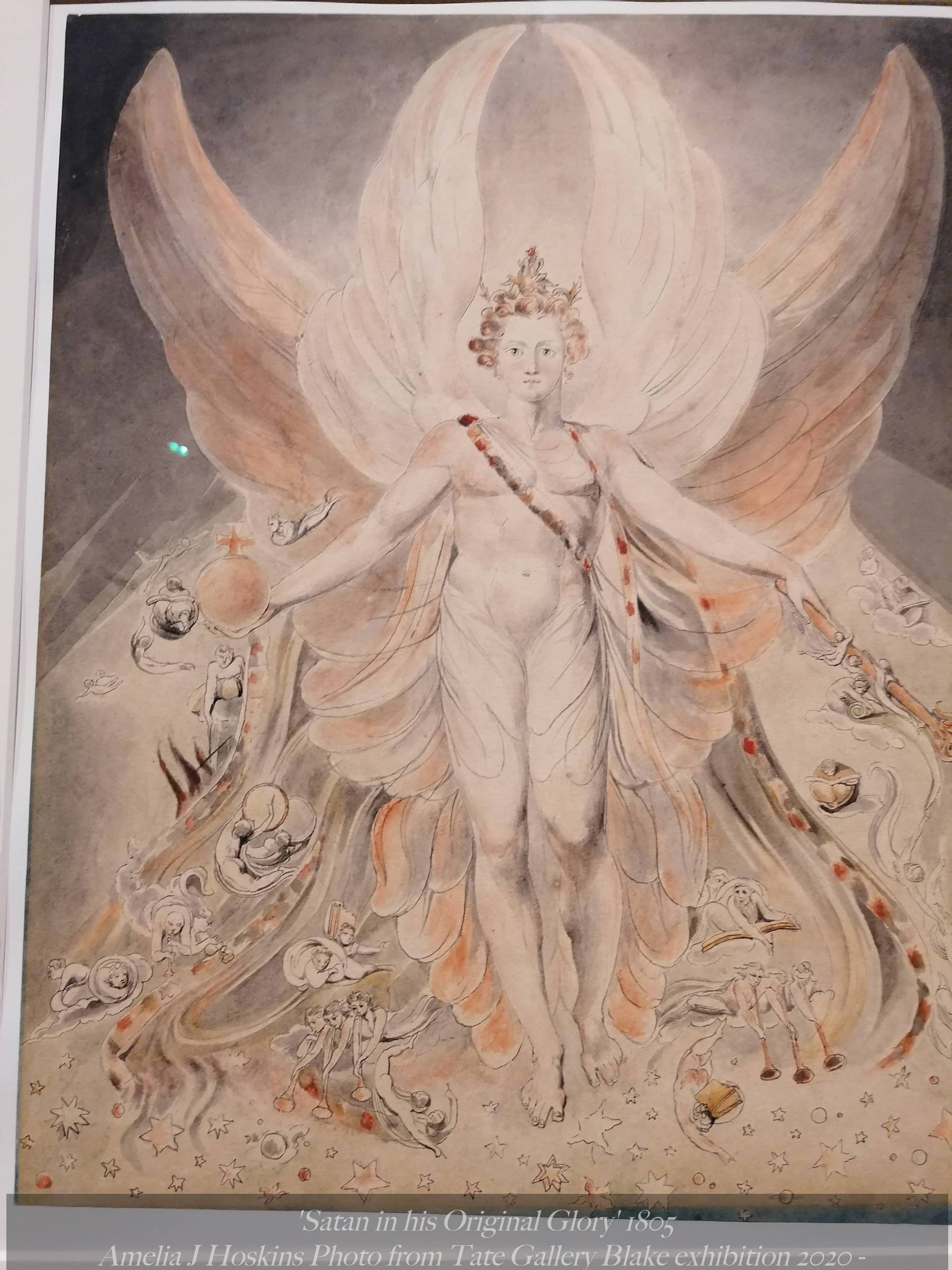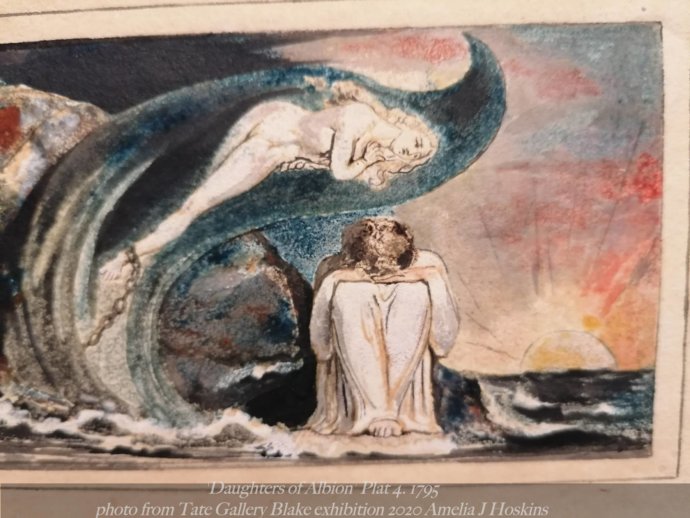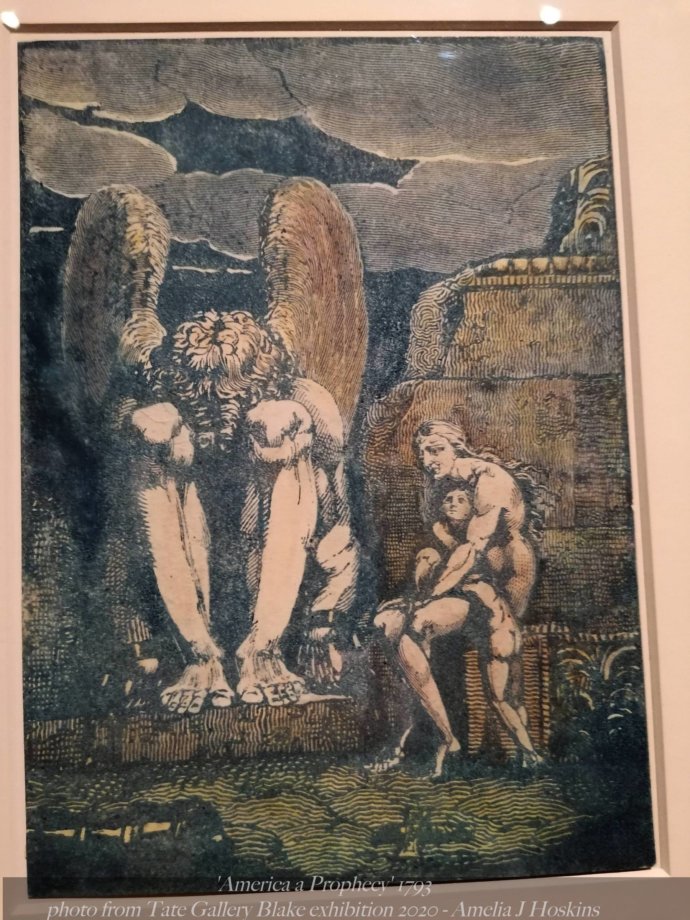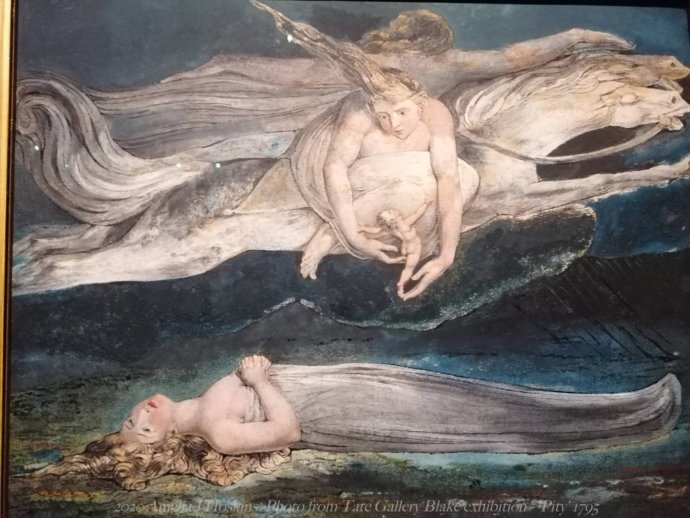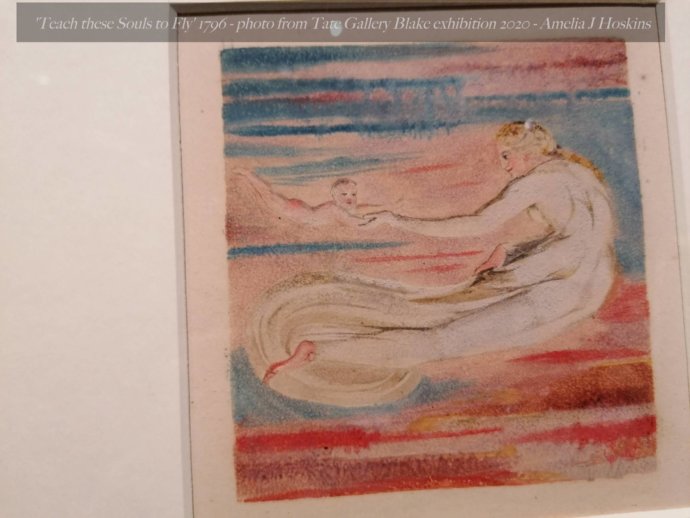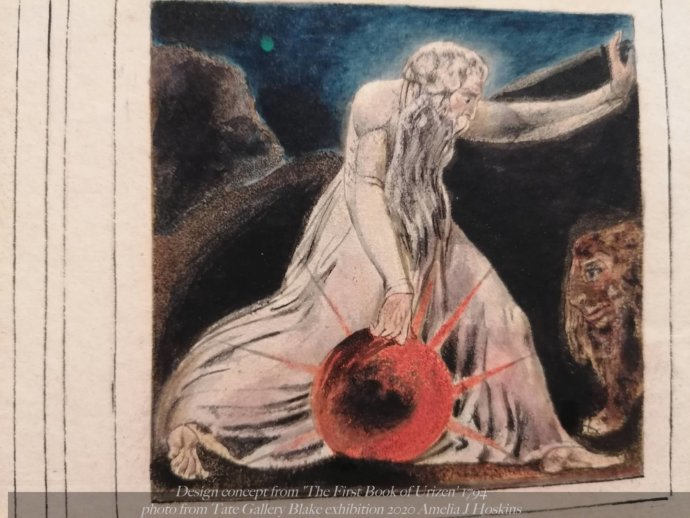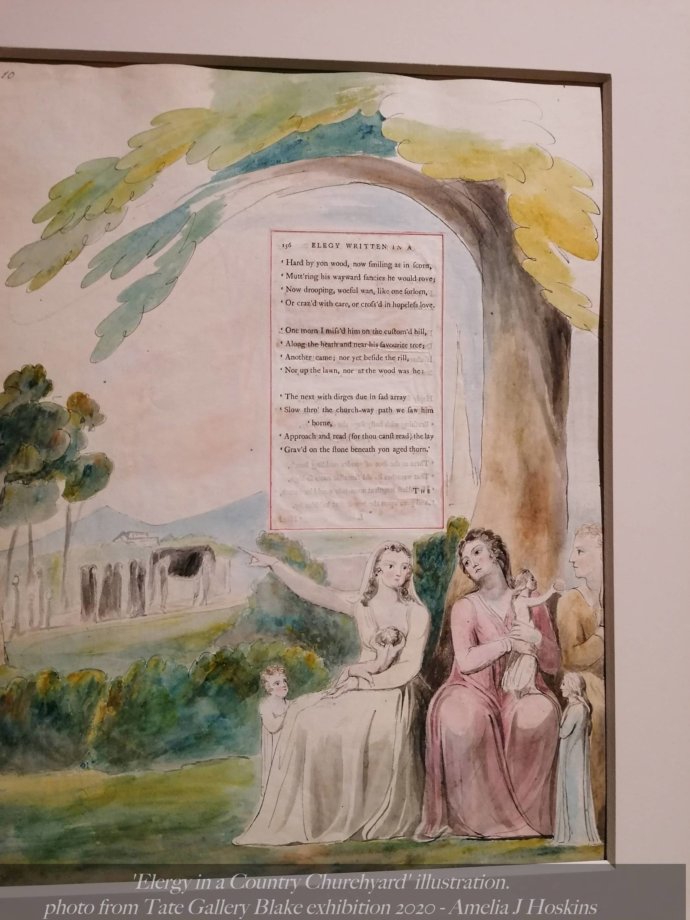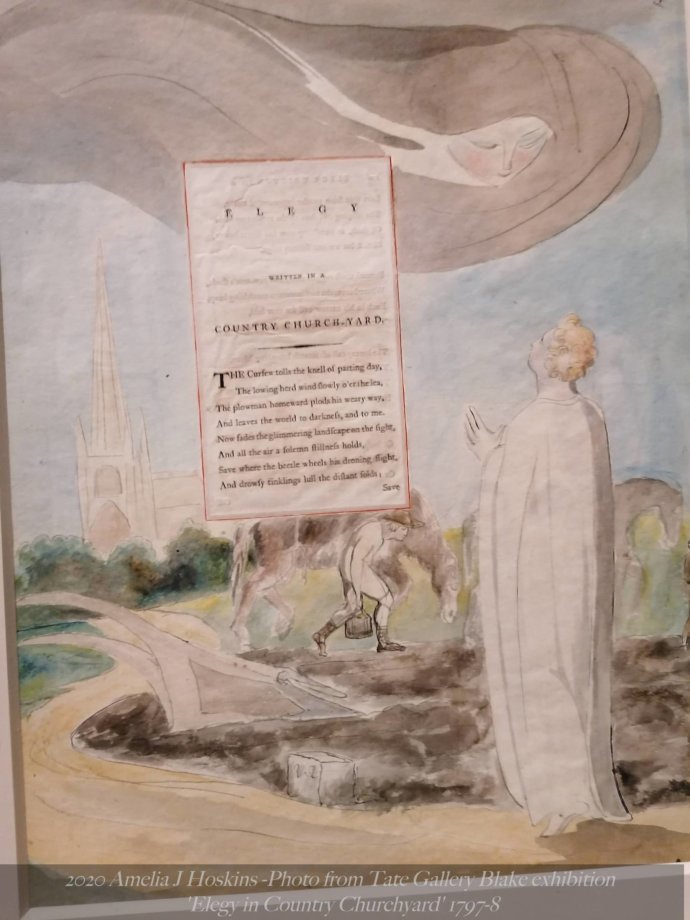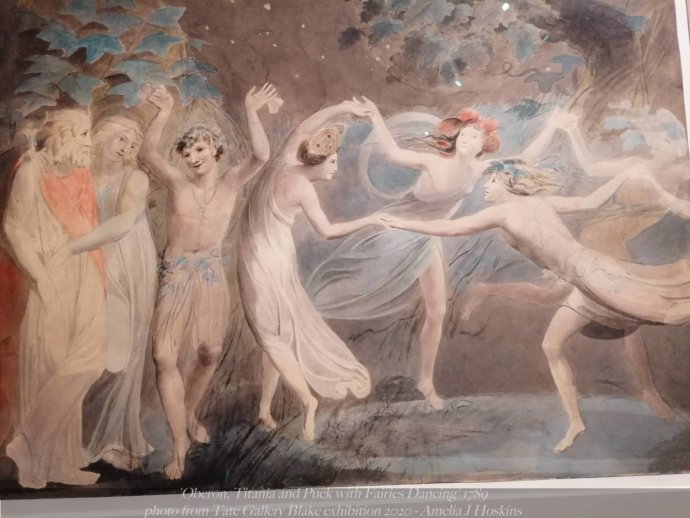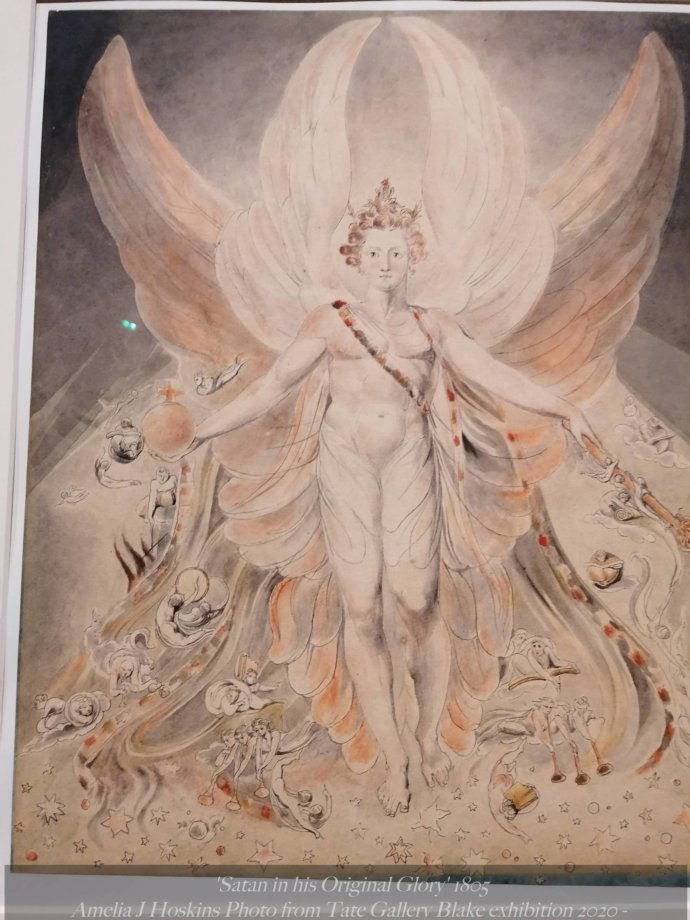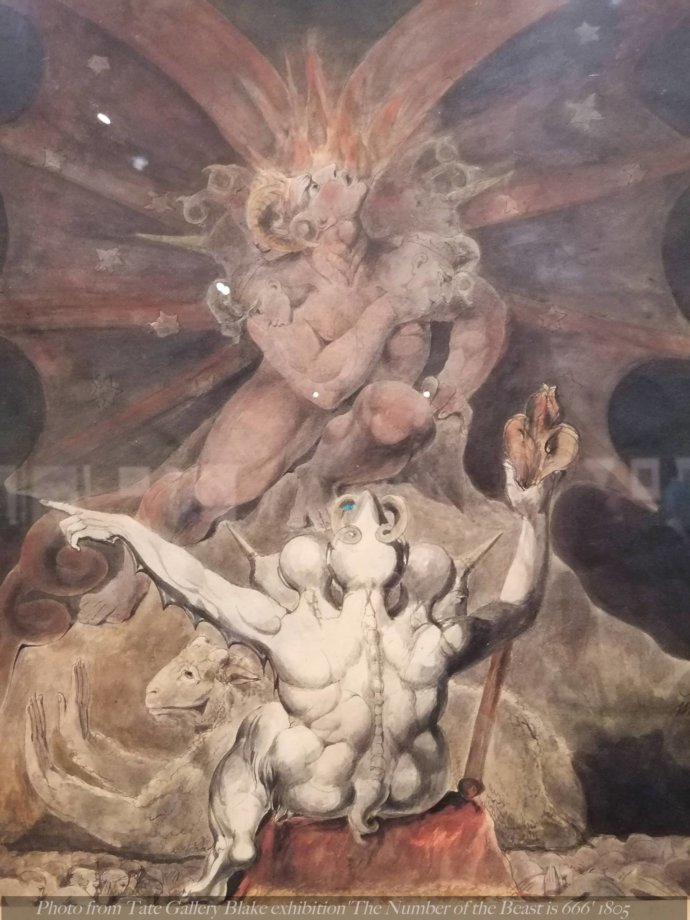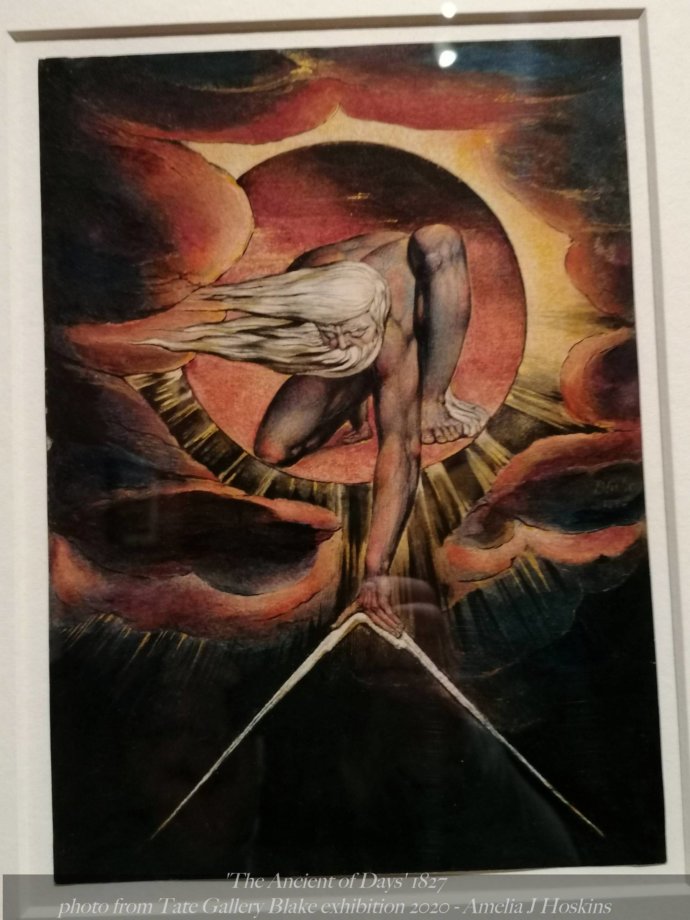Visionary - Poet - Painter - Illustrator - Engraver

'Daughters of Albion'
Quintessential Blake: an attractive illustrative design with resonant meaning. His design ideas are 'modern' to our eyes by his use of inspired graphic inventions to portray poetic ideas, which makes him an important figure behind modern art and modern graphics; yet actually a style he was ridiculed for in his own time, many believing him mad. The wave represents the Atlantic and the woman the plight of new Americans, and political separation from the homeland. The figure in despair represents Britain in despair over loss of the New World. The sun sets on the empire. The image is an allegory for the American situation during the Civil War and with England which incredibly 300 years later appears apt as America is once again under tyrannical forces.
Blake was a declared Republican; in sympathy with free America as well as free France. Resonance is shown in the symbolic poetic empathy. He was working at a unique historical time when both America and France broke from their governmental controls: monumental endeavours and times of genocide. We cannot know the psychological effect on the populations at that time living in an 'accepted' era of pink map imperialism. Today's interpretation might see the shackled woman as once again the daughters of Albion and Europe struggling for independence in a nation now infiltrated by imposters from another empire and chained to tyrannical false governments. Who knows how far into the future Blake envisioned!
BLAKE Gallery - [bottom of this post] Author's photographs from William Blake Exhibition, Tate Gallery, London, 2020. Images will be large on desktop.
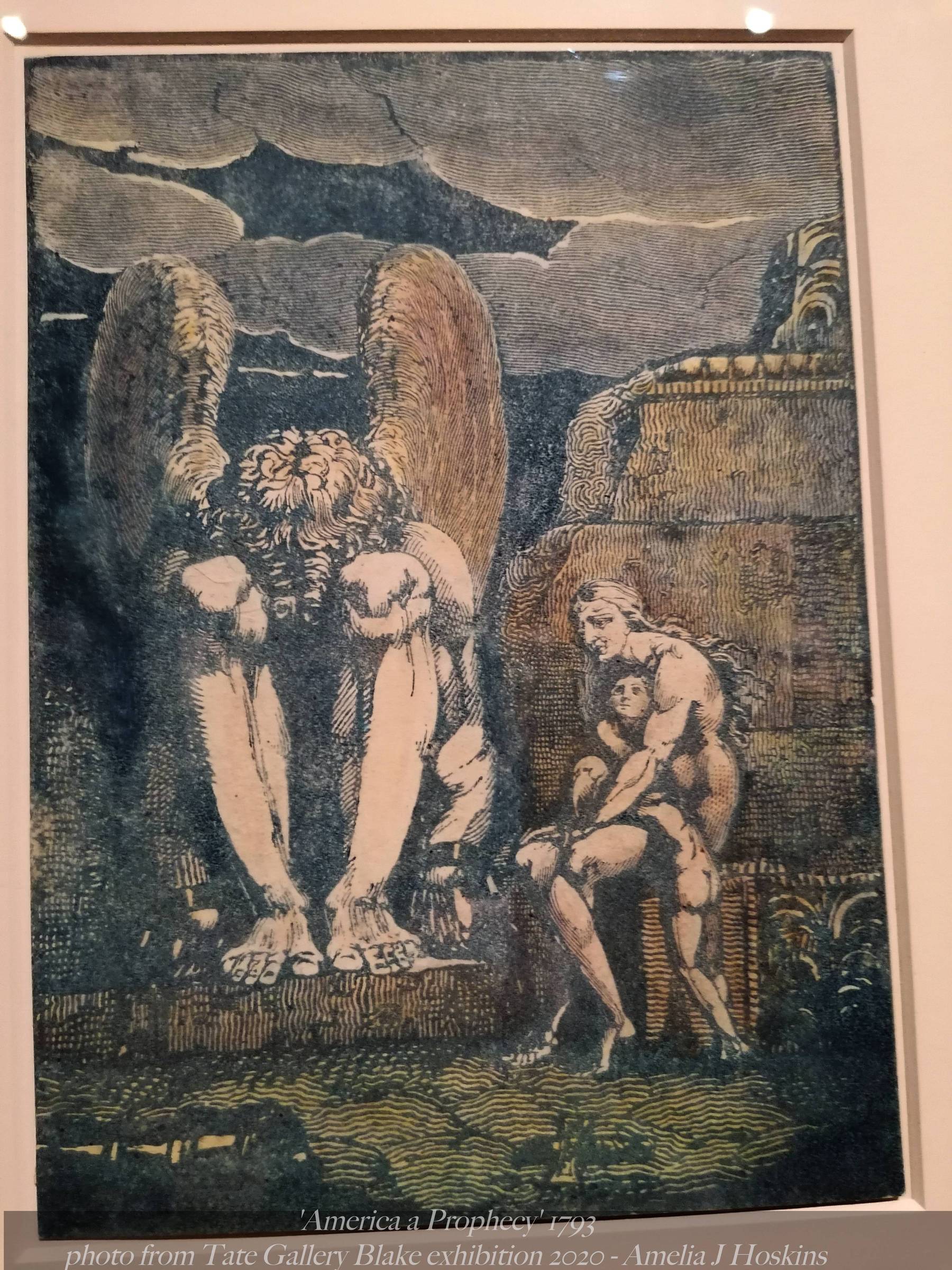
'America A Prophecy'
One of several varied etched printed frontispieces for the book of the poem. Blake was clearly inspired by the creation of the American Republic. A 'fallen angel' heavy masculine shackled figure is the 'Angel of Albion' depicted in dejected failure: representing the despair of the empire; loss of human life and power. This could have been avoided if the British had not insisted on taxation compliance. The ancient carved stone background is an allegory for the battle of empires throughout history. A woman and child represent new life, hope and the future established in the new world, but with sadness of losses during the American Civil War. (my image interpretation). To live in a time when to be English meant having an extension of another land (Empire mindset); would mean a national disturbance to have a war against one's own people. George III catastrophe.
'Teach These Souls to Fly'
A mother guides her baby to fly in lightness and bright colours. Blake is advocating independence of the individual and personal freedom, away from pious religious politics, corrupt politicians and a dark age of the new industrialism; which he saw as part of the takeover of natural human life, similar as we see today further developed as technocracy by globalists.

'Pity'
A striking painting story, which seems to be about a mother who has lost her child who is taken into heaven by angels, but does the angel represent good or evil? The dark turbulent sea combined as ground and sky, is again featured, with echoes of the 'Prophecy' works; another use of symbolic abstraction long before the more abstracted art movements. Pity is one of a combined theme of Mercy, Pity, Peace and Love necessary in Blake's better world'. [source add]
Two works representing both sides of Blake's concerns. He used figures always to represent an emotional state or controversy in society. His works of a heavenly view of happy family lightness often have an unseen message of a warning vs struggle and sadness, such as an angel with a serpent; a resonant vision vs a synthetic agenda.
'Elergy in a Country Churchyard' - book illustrations for Thomas Gray's poem
Blake also had illustrative sensitivity to depict the pastoral simple life. His usual religious theme is minimised with a simple face in cloud abstraction. Women and children are depicted entirely naturally.
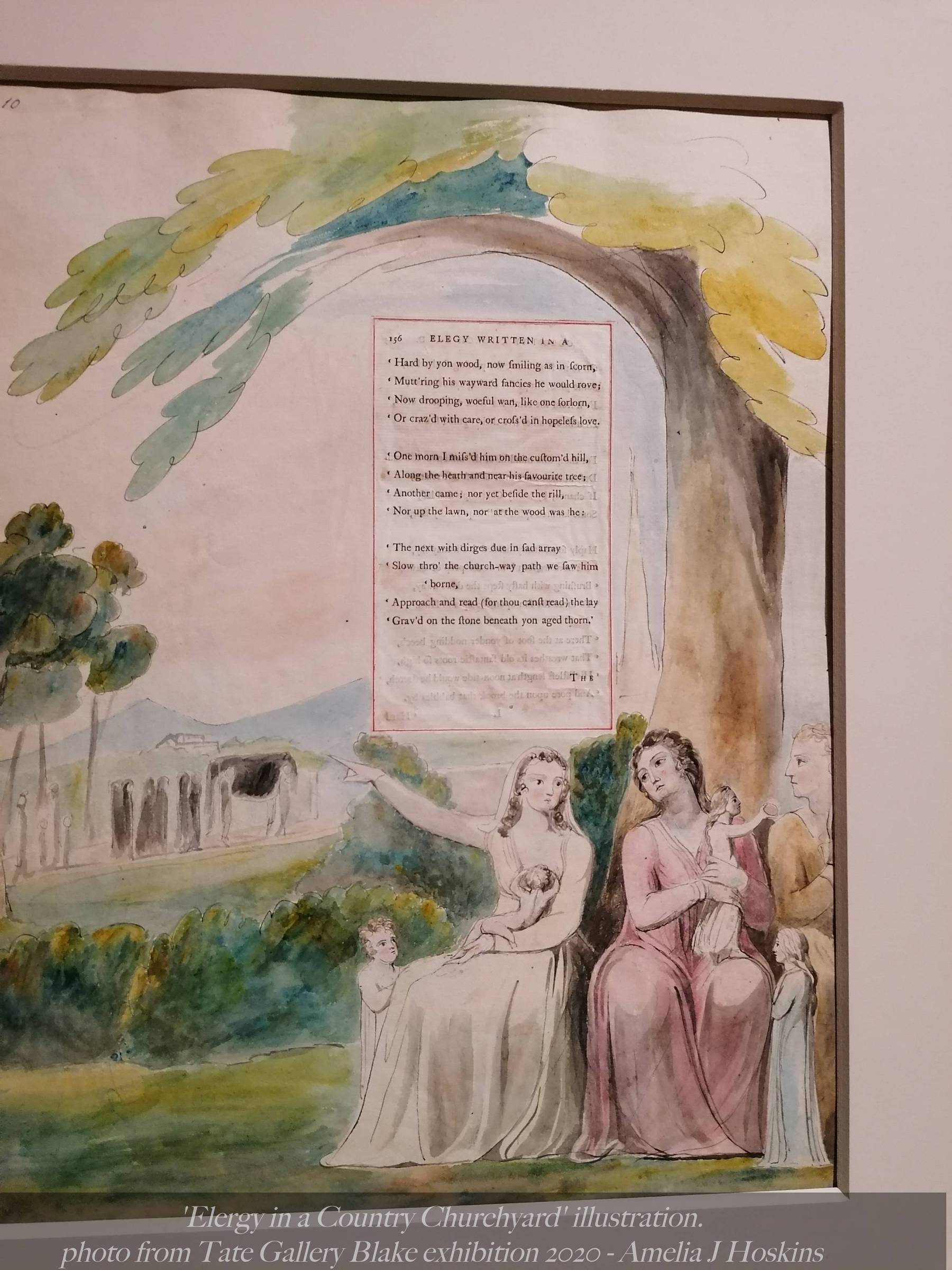
'Satan In His original Glory'
Subtitled, “Thou Wast Perfect in Thy Ways from the Day That Thou Was Created, Till Iniquity Was Found in Thee” (Ezekiel 28:15). Ezekiel’s prophecy sees Lucifer as the ‘cherub with extensive wingspan’. Sensitive lines with pastel colouring at first glance are similar to those Blake used for his heavenly and pastoral works but are deceptive. This 'angel' is Lucifer (light, sun of morn), an androgynous Satan in disguise. The orb and sceptre are emblems of kingship used in coronations. Blake reverses the hands holding the orb and sceptre, indicating the fall of Christianity and Kings: easily relatable to British vs America war, and monarchy dethroned during French Revolution. At the dawn of industrialisation Blake thought people were devoid of a real connection with a god. Christianity (the Church State) he saw as a false ceremonial political tool; a reason he emphatically used religious symbolism in his work, not only because religious art had been in demand still during his time.
Satan as Lucifer - Illuminati god of light and left hemisphere
Pivotal to much of Blake's work is his exposure of a 'Sun of Morn' as an illusion; the same 'Luciferian' god of light of the Illuminati Order, known to Blake through his knowledge of Freemasonry, with lineage from Zoroastrian and Babylonian 'sun god'. For Blake, focusing on 'light' as a divinity is a mistaken frame of mind, which has been used to control mankind for all time. In The Four Zoas his character Urizen, (ourizein: 'marks boundaries, defines horizon, separates and divides') is a recreation of the Prince of light, The Great Architect of This World, actually representing a reduction of perception through the measuring of all things, in a drive for a false sense of perfection. [Quotes taken from Golgonooza - thehumandivide.org]
'...Blake foresaw an utterly disconnected, divided Reason—“pure” Reason if you like—would not be a precision instrument, let alone a luminous Angel, but a ravenous, compulsive program, endlessly driven to dissect, devour, manipulate, and use.'
I see the swords & spears of futurity
Tho in the Brain of Man we live, & in his circling Nerves.
Tho’ this bright world of all our joy is in the Human Brain.
Where Urizen & all his Hosts hang their immortal lamps [FOUR ZOAS 11:14-17]
Blake knows joy is in the mind and the last line 'immortal lamps' refers to the continued human social engineering telling mankind to find the light out of darkness, when we can be already in lightness, rather than looking for it. “Awake! awake O sleeper of the land of shadows, wake! expand” ~ from 'Jerusalem'
God Appears & God is Light
To those poor Souls who dwell in Night
But does a Human Form Display
To those who Dwell in Realms of day [Last lines of AUGURIES OF INNOCENCE]
'For Blake, the central problem of the world, of our enslavement (our “mind-forg’d manacles”) is not capitalism, or greed, or pollution, or ignorance, or materialism, or mechanism, or technology. For him it is fundamentally spiritual: that is to say, that he believed that this dimension of reality is an essentially spiritual (or ‘psychological’) one that is currently ruled by powers and principles that are terrifying, have no interest or love for humanity, or forgiveness, but are driven by the purest values of the left brain: control, domination, purity, power, know-how, dissociation.'
We now live in a corporate world of domination and power helplessly accepted by all.
"Even his splendid logical faculties will, in real life situations, produce not actual reasoning but that imitation of reasoning known as rationalization”, as Cleckley says of the rationalising psychopath (The Mask of Sanity); at his worst, it will produce the psychotic destruction of humanity itself". (Damon)
This 'psychotic destruction of humanity' we observe in the social engineering causing a mass psychosis in relation to fake politics used in Marxist agendas in 2021 (fake election and virtue signalling).
...the forever promise of future power, and dominion, and enlightenment – but always a further twist of the screw, a further fall, a further enslavement to its false Eden. Lucifer is obsessed not with sin but with Purity. Like every rational program, it loves straight lines and purity – it’s no coincidence it’s often called Pure Reason, or Pure Science – and that’s why it hates the world of the body and human embodiment (which it necessarily sees as “impure”, a term with which it constantly seeks to get us to think of our bodies: as irrational and chaotic and full of “seething” emotions that need to be controlled, or if possible, erased – “purified”.
We can directly trace this thinking and foresight to the world of big tech and AI even in Blake's own view: "“Blake saw Newton and Locke and others as hyponitized Narcissus types quite unable to meet the challenge of mechanism.“" (McLuhan) Imagine what Blake would say about big tech and AI of today: perhaps totally incapable of meeting the challenge of artificial intelligence, now 'a ravenous compulsive program' is underway.
'The project of Lucifer, this program in our heads, is to completely disconnect and dissociate itself from the human body, and embodiment, and this Earth. In the virtualised, technologized, Silicon Valley, space-obsessed, AI world of the 21st century, this agenda is nearing completion.' [Mary Douglas, 'Purity and Danger']
'So if I am right, that the story of the Western world is one of increasing left-hemispheric domination, we would not expect insight to be the key note. Instead we would expect a sort of insouciant optimism, the sleepwalker whistling a happy tune as he ambles towards the abyss.' [McGilchrist] (study his work on the divided brain).
'The Number of the Beast is 666'
With the understanding of Blake's writing on 'Lucifer, god of light' above; this image makes more sense. Satan has become a red dragon devil. Blake was inspired by Ezekiel and Book of Revelations: the 'red dragon' and the 'beast'. 'Satan' or previously 'Saturn' had become evil and has dragon's wings rather than angels. With war so dominant during Blake's time, he developed a strong theme of 'Heaven and Hell'. His many beast illustrations are hellish with 7 headed hydra human-form devils. White devil points one way, while red devil looks in the opposite direction. The lamb has human hands, symbolising peaceful people, Christ's 'flock' on whom devilish tyranny is always wrought; sat betwixt the two devil forms. He symbolises not only war, but a battle of controlling powers, possibly depicting the Old Word Illuminati Order and New World Order of scientism.
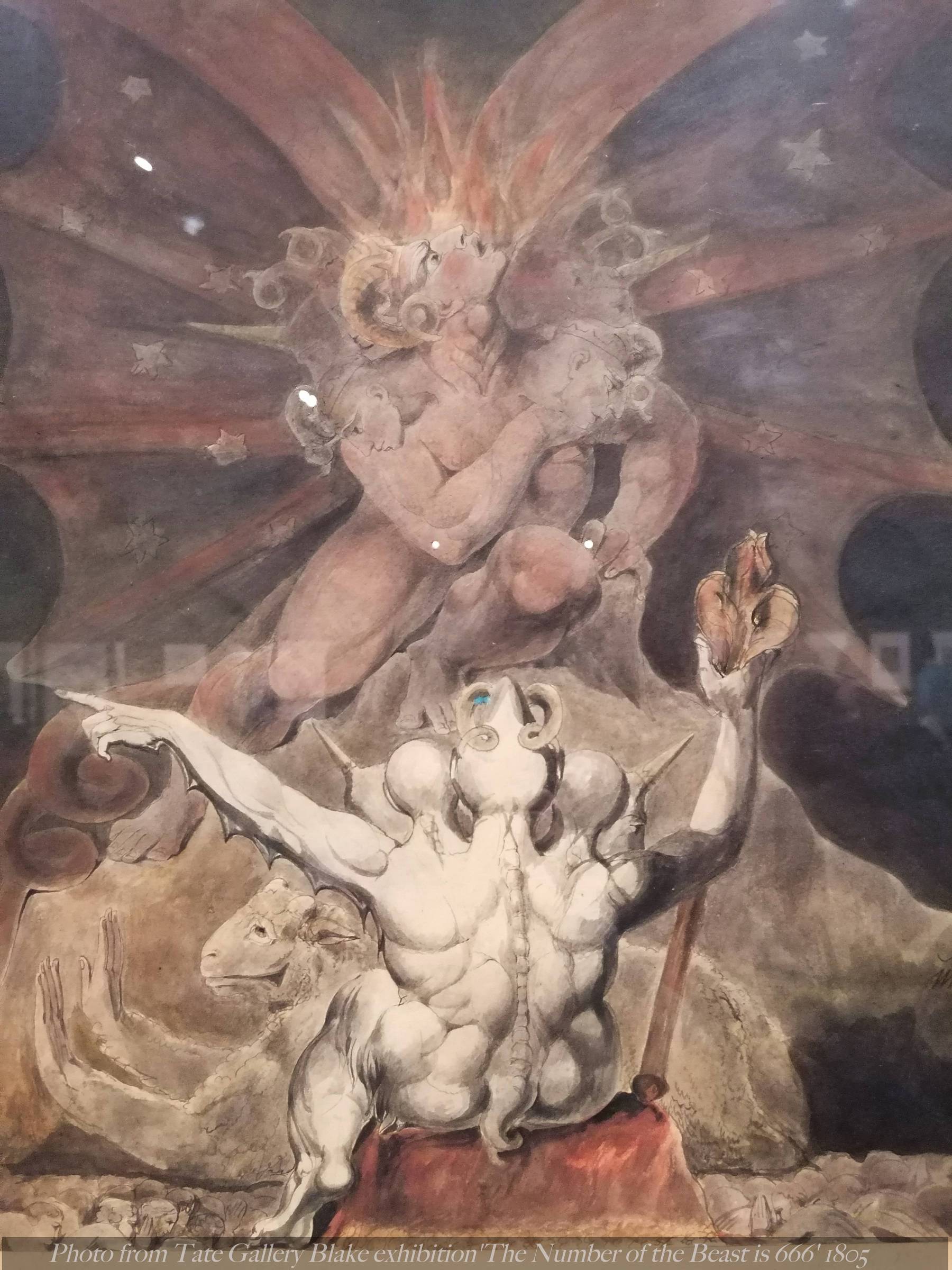
Blake and the Freemasons
Blake was well read and even active in matters of governance, aware of the political upheavals of the day, and a friend of Thomas Paine. As a student engraver he worked opposite the new Freemason building of 1776, and would have observed their ceremonies. He moved in Freemasonry circles, which were highly influential in the day, and had access to their ideas and symbols. He saw Masonry as an extension of ancient Roman power. Weishaupt's Bavarian illuminati were exposed within a growing fear of sinister conspiracies involving clandestine, fraternal associations; causing division between Illuminist Masons and the Moderns, dedicated to Newtonian science and the British monarchy. In 1792 they made a public oath of loyalty to George III in terms that characterized god as 'Supreme Architect of the Universe'. Swedenborgian Masons planned to eradicate true Christianity and sweep away every Prince and King. [Notes from thehumandivine.org - 'The Golden Compasses: William Blake and the Freemasonry'.]
200 years on we can see the plan of the 'Ancient Regime' in play and therefore we can know Blake was no mad visionary but a prophet of a future to come, who saw clearly plans which are hidden from us today. Barruel's 'Memoirs Illustrating the History of Jacobinism' (1797-8) exposed a continent wide conspiracy to overthrow all existing governments, monarchies and churches. [See work of Schuchard on Blake's involvement in Swedenborg society]
